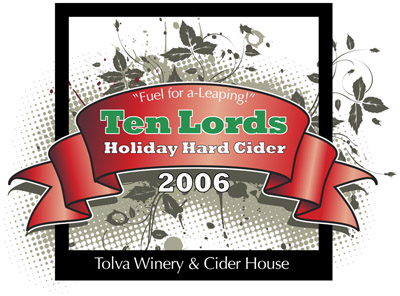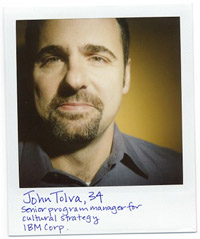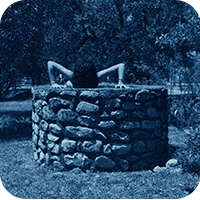Track level
A view of our holiday track layout. Complete with derailment.
Music: ’76 aka The Slow Train, Lemon Jelly
Intercoastal
For Turkey Day I spent some time with the male members of my family on the now-annual fall fishing trip to coastal Texas. This was the site of last year’s encounter with Larry the Fishing Guide. We hired him again. Most decent guides know where the fish are. Larry has a preternatural ability to know what the fish are doing. He reads the barely-subsurface topography of the intercoastal and can tell you why a school of drum is in this place but not 15 feet to the north. Of course, he’s constantly on his cell phone with other guides so there’s bit of a hive mind aspect to the local knowledge. But still. Larry’s uncanny.
Larry has a great verb: “to box.” As in “Nice one, John, that’ll box for sure.” As in “that fish is large enough not to get us arrested if we keep it so we can put it in our onboard freezer box.” To say “that’ll box” is easier, you see.
My favorite Larry trick? He sets the drag on his poles (which we all use) to the exact tension so that if the drag lets out you know you have a fish that’ll box. If the drag does not give then you’ll be tossing this particular fishie back. Think about that. Drag tension varies from reel to reel and yet he is able to set the drag precisely to differentiate a 19“ redfish from a 21” redfish. It worked too.
The new experience this year was flounder gigging. You go out at night into the extreme shallows and stand at the bow of your floodlit flatboat with a trident ready to spot-and-spear the flounder. It is so primitive and, well, satisfying. There’s absolutely no sport to it at all, but it is astonishing how much fun it is. It just shouldn’t be, but it is. Bloody too, as the pierced, spewing flounder are arc’ed into the holding tub on the end of trident.
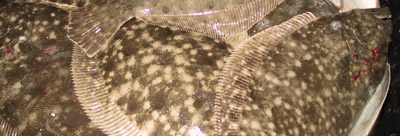
Actually the best part is the marine life you see. In those shallows with that much light at night you encounter herons, crabs, jellyfish, mullet, redfish, and even porpoise. In fact, for most of our evening we had a two-porpoise escort. They played off whichever side of our boat was away from shore, effectively pushing fish into even shallower water for us. Smart creatures! The flip side of this natural beauty is the clear evidence of human negligence. Propeller-scarred lanes of sand criss-cross the grassy shallows like a satellite photo of Europa. Granted, navigating the tricky waters and tides of the intercoastal is difficult*, but some of these scars were deep and suggest foolishness rather than ignorance.
It is a bit eerie too. Some people gig flounder without a boat by walking in the shallows. These die-hards trudge through the muck with a lantern powered by a car battery floating in a sytrofoam enclosure tethered to their waste. They also drag a bag of bleeding flounder. This is intrepid bordering on stupid given the sharks that patrol the same shallows. The last thing I’d want is to try to outrun a blood-crazed shark with a car battery strapped to my waist.
[*] Quote of the Trip: “John, do you know how to use a sextant?” — father-in-law after we somehow ended up in Corpus Christi bay at night miles away from where we should have been. I am ashamed to say that I did not know how to use a sextant. But if he had an astrolabe …
Party as a verb
The deafening silence on this blog is attributable to one thing only: the obscene workload of preparing for our holiday party. Trying to one-up ourselves each year seems to be driving us asymptotically closer to insanity. And yet, it is a damn good time, bigger than Christmas day in some ways. Certainly more work, usually more fun. It all went down on Saturday night.
We were worried about the fire marshal and the ATF. The first because we invited way too many people and we don’t have a gigantic space. The second because, well, let’s just say the freeze-distillation of the homemade apple cider succeeded.
To combat the crush of people that inevitably orbit the bartender we devised a few ploys to get people down into the basement/mancave. We set up a DJ table downstairs. Two laptops — one running the Hercules DJ Console, the other running Ableton Live — were connected to a two-channel mixer which hooked into the stereo system. The trusty Denon AVR-4306 (oh how I love that piece of machinery) ably handled playing Christmas tunes upstairs and the mixer’s output downstairs. Everyone wants to be a DJ and, after a few drinks, no one seems to care that you aren’t. (Beatmatching, like downhill skiing, is not really something to be done drunk.) It was great fun.
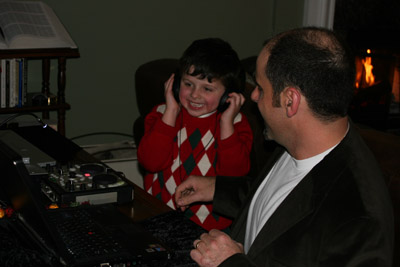
We also set up a prom-style photo wall, inspired by an excellent photostream on Flickr (which I cannot find at the moment) link (thanks, Craig). Borrowing a friend’s kickass SLR and installing some remote control software we were able to rig it so that the revelers had only to hit F9 to take their own shots. A laptop displayed the output immediately. 800 photos later, I am amazed at what people will do in front of a camera. In any event, the ploys worked and by 9pm the basement was throbbing with people vamping for the camera and thumping to the choons.
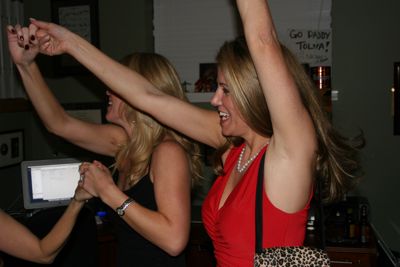
Adding to the rave-like quality on the lower level were this year’s party favors. Traditionally we’ve created a mix using Coudal’s superb Jewelboxes. One of the great things about these cases is that the hinge between the covers creates a nifty little chamber. Coudal encourages creative uses of the chamber so last year (for a mix called “Shaken”) I filled the chamber with red, white, and green Tic Tacs. I was pleased with the results. So imagine my surprise when I learned that Coudal actually now has an entire sub-line of Jewelboxes with Tic Tac-filled hinge chambers! Flattering, I suppose. (Hard not to love Coudal. Even if they did steal my idea!)
Anyway. The rave-like quality. This year I searched high and low for glow sticks that were the proper size for the hinge chamber. My idea was to have red and green glowing CDs. Turns out glow sticks are made in a bewildering variety of shapes and sizes for everything from costumes to golf balls to fishing lures. This last category — called Lunker Lights — was the perfect size for the chamber. The effect was stunning — though it only lasted for about 8 hours. Rave on! (For those who enjoy stylistically schizophrenic playlists, the tracks are listed here.)
Our ATF worries were less Ruby Ridge, more Al Capone. There’s nothing wrong with making your own hard cider, of course. It turned out very well, if a little dry. But the real hit of the party was the Applejack. This potent distillate is made by putting a quantity of cider out in the snow for a few days, letting the non-alcoholic liquid (which is most of it) freeze, scraping that off, repeating. Liquid volume reduction, no alcohol reduction. (Some pics at the end of this photoset.) You can figure out the rest. It isn’t precisely legal, but then who says I didn’t just leave the tub out in the snow by accident? Calvados is the name of store-bought heat-distilled Apple liqueur. I’m quite certain it tastes nothing like my Applejack. But people clearly drank it at the party and, refreshingly, we’ve had no reports of blindness or death.
The last bit of party fun for which I was responsible (i.e. those things having nothing to do with food or decoration) was the train track. Every year we alter the track layout a bit and this year, frankly, we might have overdone it. For years we’ve had the traditional living room and tree base interlocking loops. But that’s for amateurs we decided. And by we I mean, me and my two sons. Nah. I just mean me. So we devised the trans-dining room spur. Since we were cramped for space I laid out a single track that would head into the dining room, loop around a side table, and then return on the same track. Silly me. Electricity (which flows in the tracks and powers the engine) no likey being made to double-back on itself. So that was a colossal failure. “Daddy, why can’t you make the train run?” [heart rends] I didn’t realize you had to be an electrical engineer to build a toy train.
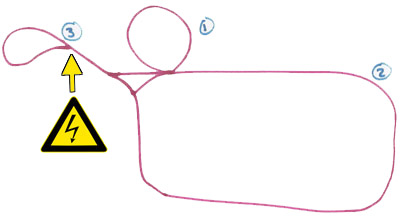
This set off a quest for two reverse loop track thing-a-ma-bobs. Inserting these into a loop of track basically segments off a stretch of track with reverse polarity so that the electrons may once again be happy and your train may run … until it gets to the junction point of the original polarity whereupon it stops and you have to go over to the control panel and reverse the direction manually. Way too cumbersome and not at all fun. So, we had to pitch the spur idea. But did we pitch the trans-dining room express? Hell no. We just made it bigger so that we could have a full fledged electrical physics-behavin’ loop. This was a source of great displeasure for my wife. (“Do you know how many drunk women in high heels are going to trip on that?!”) Chugga-chugga choo-choo.
Let’s end with the stats:
76 people drank …
2.5 handles of vodka
3/4 bottle stoli vanilla
1/3 handle gin
1 bottle scotch
4 cases of beer
2 bottles champagne
1 liter coke
1/2 handle bourbon
3 bottles merlot
3 bottles red zin
2 bottles chardonnay
1 bottle pinot grigio
1 bottle pinor noir
16 oz. homemade cider
1/2 gallon homemade applejack (god help ’em)
and ate …
9 lb ham
36 rolls
1 9×13 spinach squares
50 bacon-wrapped dates
1 bucketload of queso
2 mega-bags Fritos scoops
1 plate asparagus appetizers
2 loaves pepperoni bread
2 dozen mini-cupcakes
1/2 recipe goat cheese torta
assorted Twinkies, Ho Ho’s and cupcakes
1 apple cake
1 9×13 gooey toffee butter bars
dozens of sausage bites (1.5 packs of puff pastry)
1/2 recipe Oreo truffles
1 bag hugs pretzels
prosciutto swirls
and did not eat …
choco-covered fruits
my sister’s cookies
fudge
pralines
brownies
Until next year, happy holidays!
Dialogical
In watching Attack of the Clones again (painful indeed, but my boy asked) I noticed a strange line of dialogue. Obi-Wan at the clone factory is trying to establish a connection back to his peeps at Jedi HQ. He asks his droid to send the message “care of the old folks home.” Seemed odd, so I Googled it. Passionate discussions like this, friends, are why I love the Intertubes so.
Speaking of shows my kids watch, I’m still enamored with the Challenge of the Superfriends on DVD. Here’s one reason why. The word “doom.” It is said often and always with subwoofer insidiousness. Doom! (Actually anything the narrator says is pretty cool. I’ve had the line “Deep within the gaseous core of Saturn …” in my head all day.)
When the metaverse is your town hall
Tuesday in Beijing I was part of a team that did something truly bizarre and unique. We helped the CEO of IBM, Sam Palmisano, deliver the results of IBM’s Innovation Jam to an audience inside of Second Life. The virtual venue complemented the 8,000 IBM’ers in China he was speaking directly to as well as the hundreds of thousands of colleagues watching the event via internal webcast.
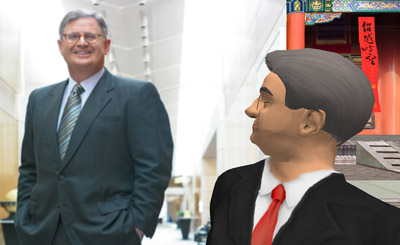
The reason Palmisano did this was to highlight IBM’s commitment to virtual world technology, one of ten new focus areas coming out of the Innovation Jam. (Roo’s got a bit more detail on the other Jam ideas over at Eightbar.) So, rather than just say we’re committed to the space, we figured we’d have Sam show it. Sam carried on a conversation with Irving Wladawsky-Berger, who was at a supercomputing convention in Tampa, via Second Life and phone line while a few dozen IBM’ers from around the world milled about smartly.
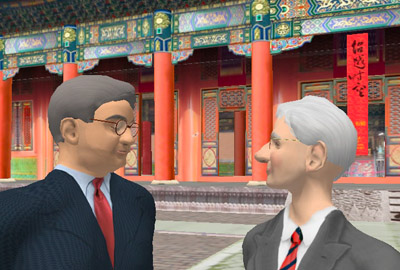
It was truly challenging to pull off, though not for the reasons you might expect. The execs were very positive and open-minded about showing a live interaction in Second Life. Trouble was, preparing for doing so in China was a nightmare of failover and logistical planning. Basically every shred of what we hoped to do live had to be filmed machinima-style as a backup in case we lost the connection. Thankfully, it stayed stable at showtime, but the virtual filming easily consumed 95% of our prep time. You just try corralling talented, curious, script-wielding colleagues in Second Life to serve as virtual extras. It is like arranging toddlers for a photo shoot. Everyone wants to show off their latest set of wings or ability to make it rain. It took forever. Still, we had to have the video. So much easier than trying to explain to 8,000 people that the grid’s down.
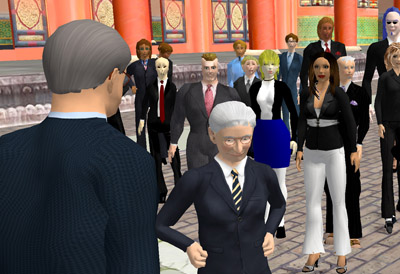
For the actual event, I was in Beijing with small group of colleagues to anchor the Sam-side interaction. We too were organized for failover. One colleague served as the vitual camera person, another was her backup and video triggerer. Others maintained contact with the IBM crowd, directing them and prepping them for the moment when Sam would “enter” the virtual world being displayed to the real audience in Beijing. Virtual webcasting.
The setting for all this was Thinkland, a private IBM island in Second Life that serves as a testbed for the Forbidden City project mentioned here previously. While the project itself will not ultimately live in SL and only launches in 2008, having a ready virtual environment so clearly China-themed was too good to pass up. Thinkland became the “stage” for the virtual event.
The press response has been strong. BusinessWeek had the exclusive (I believe) with ZDNet, Reuters (and their SL bureau), and a slew of others following closely behind.
Can’t wait to see what happens now. IBM’s ad hoc Virtual Universe Community accomplished a stunning amount of work as a non-organization. Let’s hope the new funding and focus doesn’t squelch any of the passion that has fueled the group to date.
UPDATE: Irving blogs this in much greater detail.
Spot the wall
While the debate rages about whether The Great Wall of China can or cannot be seen from orbit, I can confirm that it can at least be seen from an airplane on a clear day. What a treat on my approach to Beijing.
Terrible Twos
On Oct. 1 Ascent Stage turned two. True to form the blog is behaving like a toddler: less predictable, more prone to outbursts, and frankly stinkier.
But let’s have a look at this objectively.
Since inception there have been 458 posts, but only 142 posts in its second year. Way behind year one pace. In fact, I’d have to exceed the number of posts year-to-date in the last two months of this year to equal last year.
There have been 303 comments to date. The most commented posts almost perfectly correspond to the most viewed pages (which makes sense). Here are the top three most visited pages:
How To Build a Lego Mosaic
Ascent Stage Home Page
Tonsiloliths
These three pages account for almost two-thirds of all content views. Even more striking is that the two actual posts minus the home page account for 44% of all site traffic. That’s kinda depressing. Almost half of traffic for two lousy posts? Clearly Howto’s and obscure medical phenomema are key to Google-derived traffic nirvana.
Rounding out the top ten, but far, far distant from the top three are:
The Genographic Project
The Forbidden City: Beyond Space and Time
Outlook Detox
The topic category Science/Tech
Nike plus iPod minus Nike
The topic category Music
Deprivation and Focus
Most of the top posts came from this year. Quality not quantity, baby. Strangely missing from the top ten is Satisfying Inconvenience, the most commented-on post ever.
I’ve posted 865 marginalia links on del.icio.us since inception. That, at least, exceeds one a day.
Browser stats:
Internet Explorer: 57%
Firefox: 34%
Safari: 7%
The IE numbers are dead on for the Internet average while Firefox is slightly higher than the norm. I guess I’ve pissed off Opera users somewhere along the way.
And the platform breakdown:
Windows: 85%
Mac: 14%
Linux: <1%
That's about 10% higher for Mac users than the Internet norm. Does this mean I'm cool?
Happy birthday, Ascent Stage.
Fortnight
Last week I was in Cyprus — that small island tucked into the northeast corner of the Mediterranean. Getting there was perhaps too much of the adventure. First, I could hardly find a flight. The online travel tool was at a total loss and I wasn’t much help. That the country is split between a recognized entity, the Greek-dominated Republic of Cyprus, and the non-recognized Turkish region to the north, didn’t help flight plans either. Add to this that the name of the capital “Nicosia” is not what Cypriots call it (“Lefkosia”) and that the airport is in a different city altogether and you have a planning nightmare. But it gets better. While booking the travel agent informed me that though there were a few flights on Lufthansa coming in, there were no flights going out. Say what? Do they ship the planes off the island? While she was trying to sort this impossibility out she gladly offered up flights on a Cypriot carrier. A little voice in my head resulted in a quick googling that reminded me that, no, I’d rather not fly on a Cyprus airline. I like landing near mountains, not into them. In the end we got it all sorted out with a connection in London.
But oh the connection in London! The security procedures following on the foiled chemical explosives plot have gnarled Heathrow fiercely. The queuing clusterfuck was a thousand times worse than I’ve seen domestically — and that’s saying quite a lot in post-9/11 America. I ended up missing my Cyprus connection. So, I was re-routed to Frankfurt for a [pause to shudder] seven hour layover. I found a quiet corner and a reclining chair, locked my laptop to my body, and fell asleep. When it was all said and done and I was in my hotel room in Nicosia it was 5am. Just four short hours until my keynote talk at 9am. I’m told I did fine, but frankly I don’t much recall it. I might as well have been drunk I was so dazed.
I didn’t see much of Cyprus. Nicosia is on the interior and most of the beauty is found on the coasts, or at least that’s what the throngs of Eurotourists would suggest. As a former British holding Cyprus still drives on the left, always a source of white-knuckled passenger-side terror for me. It caused me to reflect that most left-driving places in the world are actually islands, remnants of imperial road habits. This makes sense. Being islands, places like Australia, Japan, and the British Caribbean can drive however they want since their roads don’t link up with right-driving roadways. But left-driving isn’t only for islands. India and much of sub-Saharan Africa drive on the left. So my question is: what on earth happens when you cross the border in your car to a right-driving country? I envision a morass of confused motorists surrounded by small mountain ranges of junked vehicles that simply didn’t make it. Anybody know how this works?
Part of my duties in Cyprus included meeting with prominent persons connected to cultural heritage management on the island. I had the pleasure of meeting Bishop Nikiforos of the Cypriot Church. (Greek Cyprus is Greek Orthodox, but it has a centuries-old tradition of complete autonomy from the official Greek church in Istanbul.) Nikiforos might be the next Archibishop of Cyprus depending on elections this week. It would be the equivalent of the Cypriot Pope. But he’s a humble guy, really. What I didn’t know is that I was supposed to kiss his hand. I didn’t know because I wasn’t told. I just shook his hand all American-like. Howdy, partner! My colleagues quickly did the shake-and-kiss and all I could muster was a look of complete ignorance. I couldn’t even refer to him correctly. My colleagues and I spent about a half hour trying to figure out the English equivalent of the Greek honorific that is bestowed on a bishop. They kept saying I should call him “Beatitude,” but I knew that didn’t sound right. He wasn’t a proverb. Finally we figured that I needed to address him as His Beatific, a word, yes, but not one that just rolls off the English speaker’s tongue. I might have said it once, but it sounded so silly that I just mumbled and kept on talking. Frankly, I’m surprised I was let off the island for such heresy.
I missed Halloween while I was there. This was doubly bad since Halloween is one of my favorite holidays and it is the birthday of my youngest son. I mentioned this to one of my Cypriot colleagues. Clearly she felt bad about it because she secretly had the hotel create an authentic Greek toga costume for me. She even had a local florist fashion a laurel wreath from an olive plant. So, there I sat at 4am Cyprus time alone in my room waiting to videoconference with my trick-or-treating family back home hoping like hell that there was no fire emergency in the hotel. Wouldn’t that have been a sight. Who’s the fratboy American in the lobby?
Nicosia in many ways is a sad place. The medieval town center enclosed by beautiful Venetian walls is crudely bisected by the UN buffer zone separating the Greeks from the Turkish. The difference between the two sides is striking. Though the border is much more permeable than it used to be, the economic disparity is real and obvious. Greek Cypriot troops and the Turkish military stare each other down while UN guards maintain order. Animosity over the Turkish invasion of 1974 is so palpable and frankly stated that you’d think it happened last month. Clearly it is a wound that will take generations to heal: one of my Greek Cypriot colleagues noted that the house he grew up in in the north is now a UN depot on the first floor, a Turkish residence upstairs, and a brothel in the basement. A terrible predicament to be sure, but I couldn’t shake the feeling that this was so much ado about a truly tiny place. I certainly don’t have a solution, but stepping back a bit it is obvious that Cyprus is far too tiny to be split in half, especially given its historical role as a crossroad of cultures.
From Cyprus I went back to London for a few days of meetings. Turns out I showed up for Guy Fawkes Night, which is actually Guy Fawkes Weekend as far as I could tell. The country seemed to be shooting off fireworks from the moment I arrived to the moment I left. I might actually be suffering from post-traumatic stress disorder the shelling was so constant. But you really must applaud a holiday based on a foiled plot to detonate parliament. One wonders what they are really celebrating — that Guy didn’t succeed or what it would have been like (BOOM!) if he had?
Waiting for my flight home I queued in back of an irate American woman demanding recompense for the $300 of cosmetics that the BAA relieved her of at Heathrow. I just shook my head and took my seat. Turns out this irate American was my seatmate. And her anger was more understandable than I had at first thought. She had all her items neatly measured and baggied, per the guidelines. When she departed Germany to make her connection in London British Airways told her that the bag was fine. Yet, in Heathrow they yanked it.
Say what you will about carrying several hundred dollars’ worth of cosmetics on your person, but she had a good excuse: she was Nancy Gustafson, a professional opera singer. And not just any opera singer as I would learn over the next few hours, but one of the best, a frequent soprano collaborator with every one of the Three Tenors. My first comment was “But, but, you’re not fat. Aren’t you supposed to be fat?” Like she’d never heard that before. It was a fascinating conversation. Basically the top tier of opera singers have no home. They travel the world constantly. She was practicing in her seat for a Russian opera to be performed in Tokyo on Tuesday. This was made more difficult because she doesn’t speak Russian and, well, belting out practice verses on an airplane is generally frowned upon. She was also suprsingly geeky, carrying a Vaio, MacBook, and Treo. And her iTunes library, whoa! Let’s just say there’s not a great deal of overlap with my library. She did have some pop in there, though, including the first track in the library wonderfully titled “I Don’t Give a Fuck.” See, even opera singers slum it sometimes. Nancy’s website is down at the moment, but you can learn a bit more here.
And so, to the two of you who’ve made it this far: you’re insane, but thanks. Must make shorter posts!
40<40
So here’s the deal on that post about the L train photo shoot. In what can only be described as a momentary lapse of reason, the good people at Crain’s Chicago Business have selected me for their annual 40 Under 40 issue. Sorry if reading that just made coffee shoot out your nose. It’s true. They think I’m important.
The theme of the issue was “sanctuary.” The reporters wanted to know where we went to get away from it all. Well, they picked a bad few months to ask me. With the birth of my daughter (and two rambunctious boys) this summer was completely up-ended. Hmmm, sanctuary, sanctuary? Does locking myself in the bathroom count? Home is crazy; work is crazy; so that left only the commute in between. And thus was born the idea that riding the train is my escape.* This is true to some degree. I can relax, read, or just people-watch. I should probably thank my profile’s author, Mark Scheffler, for not making me out as some sort of trainspotting lunatic.
The issue is full of lots of interesting stats. Would you believe none of the 40 Under 40 (which actually total 43, huh?) has a tattoo and that the honorees are overwhelmingly Cubs fans? The best part is that I get to see fellow honoree Jason Fried (of 37Signals) tomorrow night and (re)introduce myself as a “merchant of complexity.” What a perfect intro line.
So the full profile is online as well as a little slideshow of honorees. The print version is out today.
[*] Ironically the editor chose the easiest photo (me just sitting on the train) for the issue. I can only guess that the several dozen gigabytes of shots of me on the train platform seemed too much like an escape of a different sort. Don’t jump, man!
All it takes is one bad apple

Luckily we found that one bad apple and removed it from the bushel before embarking on this weekend’s adventure to make hard apple cider.
It was a lot easier than making wine. And yet, so much more work than I anticipated. For one, it is difficult to find detailed information on cider-making. Sure there’s the Intarweb, but the info is suprisingly scarce, nearly always tacked on as an appendix to beer-brewing how-to’s. For another, virtually no cider recipe begins with actual apples which I suppose follows from the first point. I mean, how many beer brewing recipes instruct you on how to harvest your own barley and hops? (This is the biggest difference with amateur winemaking. People love starting with actual grapes.)
So we had all these apples. And they’re something like 93% liquid. But getting all that juice out is nearly impossible without a good masher and press. We had neither. So we sliced up all the Empire apples (which by sheer luck turned out to be good for cider-makin’) with one of them corer doodads. It was handy for sure, but every slice tossed up a reverse shower of apple juice into my face. By the end my face had hardened into a sweet citrus-encrusted mask.
The goal is mash up the apples enough so that squeezing the juice from them is easier than trying to squeeze a whole apple. (This is why apples are called a hard fruit. Yes, just got that.) We had a grape crusher from our stint as home vintners ten years ago which we thought would work perfectly. It did not work perfectly. Indeed, it did not work at all. The few slices that did get mulched in the gears merely created a slurry coating that prevented other slices from entering. So we abandoned that idea.
Ultimately we put the slices into a food processor with the grater blade in. This worked wonderfully, though it kinda technologized the romance out of the process. Just for a bit, though. The real manual labor commenced when we had to hand-wring the mashed apples through cheese-cloth to get the juice out. My kingdom for a fruit press! Imagine wringing several hundred delicate washclothes out. Our hand muscles were basically useless when it was all done.
Now, there’s only so much juice you can extract without the using of a simple machine. I tried to fashion a crude press from a cutting board and a pan. This failed miserably too. So we had no second run. Ultimately we had to add some fresh apple cider from local orchards to top off the carboy. Then we just added some yeast and sugar. It is cloudy but certainly looks like apple cider. In a few weeks we’ll apparently have hard cider.
At one point in this process my wife asked nonchalantly “Is there any possibility that this will kill us when we drink it?” I answered no of course. Potentially lethal apple-based liquor awaits the next step: applejackification. But that’s another post.
Full photo gallery here. Bottoms up.


